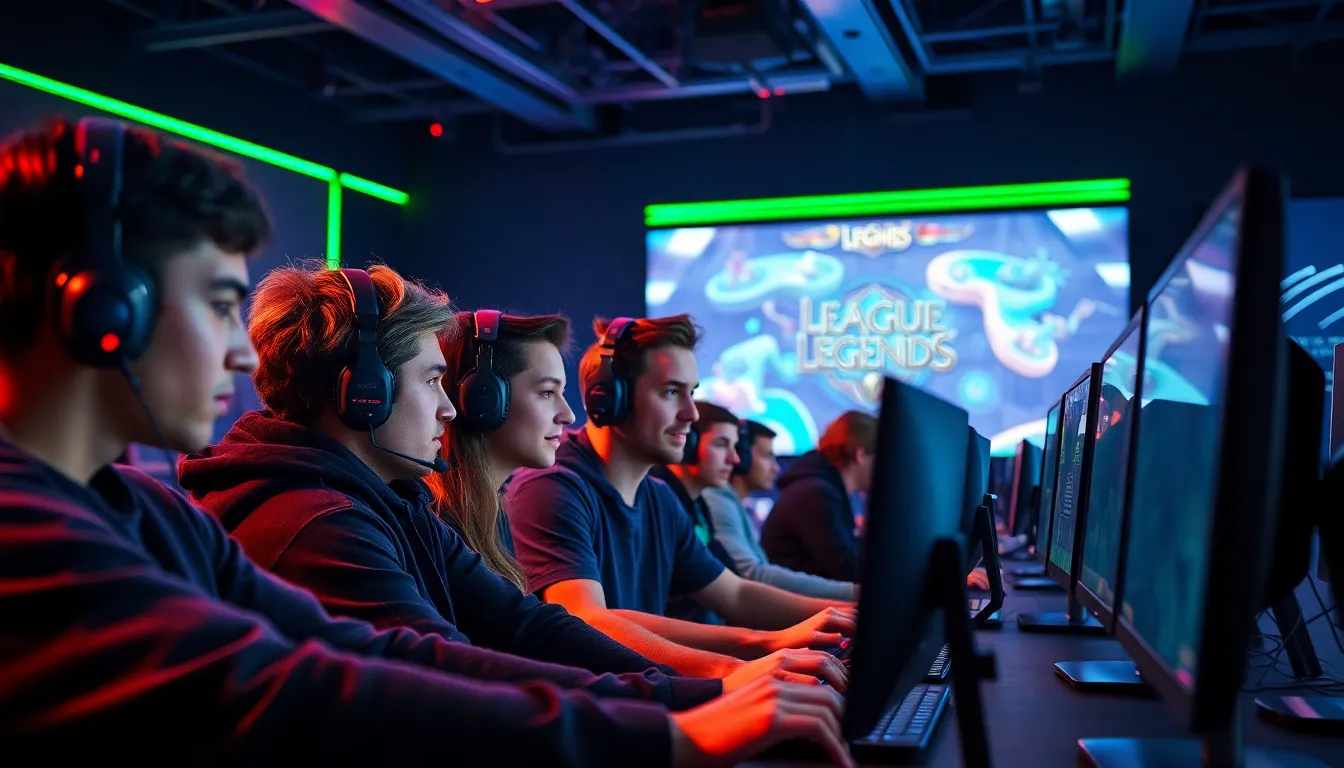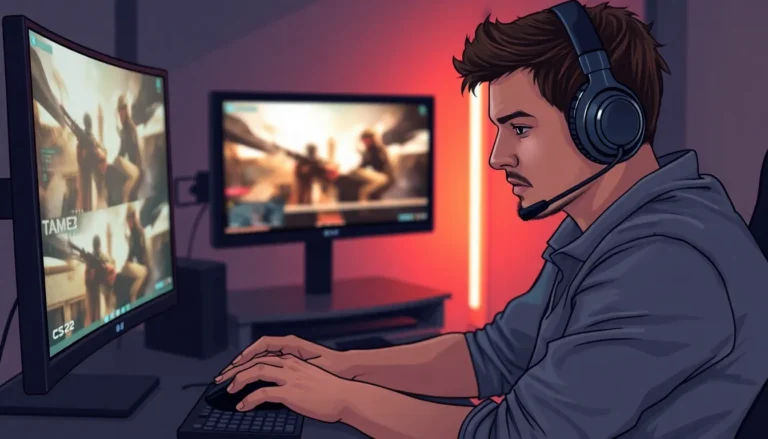In the fast-paced world of League of Legends, mastering macro play is like learning to dance at a party—everyone wants to do it, but only a few manage to pull off those smooth moves. While flashy kills and epic plays get the spotlight, it’s the strategic decisions that truly lead to victory. Understanding how to control the map, manage resources, and coordinate team efforts can turn a struggling game into a triumphant comeback.
Imagine being the mastermind behind every successful team fight, orchestrating your teammates like a symphony conductor. With the right macro strategies, players can elevate their game from mere mortals to legends. So grab your favorite snack, buckle up, and let’s dive into the world of League macro play, where strategy reigns supreme and the only thing more satisfying than a well-timed Baron steal is watching your enemies rage-quit.
Table of Contents
ToggleUnderstanding League Macro Play
League macro play involves strategic decisions that shape the flow of the game. Mastering this concept helps players improve their chances of victory. Map control represents a crucial element, allowing teams to dictate movement and positioning. Prioritizing objectives, like dragons and towers, significantly boosts a team’s effectiveness.
Resource management plays a vital role; managing gold and experience efficiently enhances team strength. Teams should focus on farming minions while minimizing enemy interactions whenever possible. Communication among team members reinforces coordination; clear callouts can shape strategic moves.
Timing presents another key aspect of macro play, impacting when to engage in fights or take objectives. Adapting strategies based on the enemy’s movements ensures responsiveness to changing dynamics. Promoting vision through wards and scouting reveals critical information, enabling informed decisions.
Objectives should always be a priority. Properly timing when to roam can lead to advantageous situations. Rotating players around the map enhances pressure in lanes, creating opportunities to take objectives.
Team composition influences macro strategies; understanding champions and their capabilities leads to better decision-making. Executing effective pings can signal intentions and increase team awareness. Engaging in skirmishes at the right moment can turn the tide in favor of the team.
Ultimately, mastering macro play blends strategic foresight with team dynamics, essential for achieving victory in League of Legends.
Key Elements of Macro Play

Mastering macro play in League of Legends revolves around several critical elements that dictate the flow of the game. Understanding these components enhances overall gameplay strategy.
Map Awareness
Map awareness reflects a player’s ability to recognize enemy positioning and movements. Constantly monitoring the minimap enables timely reactions to threats. Noticing missing champions allows for safer decision-making and adjustment of strategies. Effective ward placement promotes visibility in key areas, diminishing the risk of ambushes. Teams should communicate frequently about enemy locations to inform teammates and adjust plans accordingly.
Objective Control
Objective control emphasizes prioritizing crucial game objectives such as dragons, Baron Nashor, and towers. Securing these objectives often leads to significant advantages. Teams gain vital buffs and enhancements that strengthen overall performance. Gathering information about enemy positions before objective engagement ensures proper planning. Focusing on objectives instead of kills often determines victory, as it translates directly into securing map dominance and resource advantages.
Rotations and Positioning
Rotations and positioning play a pivotal role in macro play. Effective rotations maximize team efficiency in responding to in-game situations. Moving together reduces the risk of getting picked off while maximizing pressure on lanes. Proper positioning during fights allows teams to capitalize on advantageous scenarios. Understanding where to be at any given moment fosters a superior tactical advantage. Coordinated rotations create opportunities for taking down objectives and securing lead in the game.
Strategies for Effective Macro Play
Effective macro play requires understanding key phases of the game, especially during early stages and transitions to mid and late game.
Early Game Macro Decisions
Early game decisions impact the overall game flow. Prioritize establishing vision control by placing wards in strategic locations. Focus on coordinating with teammates for optimal objective control. Securing first herald or dragon can grant early advantages. Consider lane matchups and capitalize on advantageous situations. Players should rotate to assist lanes in need while maintaining jungle pressure. Maintaining awareness of enemy movements influences decision-making. Avoid overcommitting to fights unless conditions favor the team.
Mid to Late Game Adjustments
Mid to late game transitions demand strategic adjustments. Focus on grouping with teammates to secure objectives such as towers and dragons. Keep communication open for timely rotations and potential ambushes. Adjust positioning based on opponent strengths and weaknesses. Evaluate team composition for scalability in fights and objectives. Continually assess the game situation to decide between siege and retreating. Prioritize securing vision around critical areas like Baron and enemy jungle. Understanding timing for engagements translates to better map control and team success.
Common Mistakes in Macro Play
Players often encounter key mistakes in macro play that hinder their success. Recognizing these pitfalls is essential for improvement.
Overcommitting to Fights
Overcommitting to fights leads to detrimental outcomes for teams. Players may focus on securing kills rather than considering the broader implications for the match. Engaging in fights without strategic backing often results in unnecessary deaths. An example exists when a player dives into multiple enemies without vision support, leaving their team vulnerable. Engaging for prolonged periods can also expose teammates to counterattacks. Prioritizing objectives over kills strengthens overall gameplay, creating a more advantageous situation for teams as they transition into late game scenarios.
Neglecting Vision Control
Neglecting vision control creates blind spots that teams cannot afford. Losing the ability to spot enemy movements often leads to ambushes and missed opportunities. Players should prioritize ward placement in critical areas, such as dragon or Baron Nashor. Wards provide valuable information for informed decision-making and safer objective takes. Supporting teammates through effective communication about missing enemies significantly reduces risks. Teams that invest time in maintaining vision not only avoid unnecessary deaths; they also enhance their ability to execute strategies effectively. Prioritization of vision control correlates directly with improved macro play.
Mastering macro play is essential for any League of Legends player looking to elevate their game. It requires a blend of strategic thinking and teamwork that goes beyond individual skill. By focusing on map control resource management and effective communication players can significantly improve their chances of securing victory.
Prioritizing objectives understanding team dynamics and maintaining vision are key components that lead to success. As players refine their macro strategies they not only enhance their gameplay but also contribute to a more cohesive team effort. Embracing these principles will ultimately transform how players approach each match turning them into formidable opponents on the Rift.



